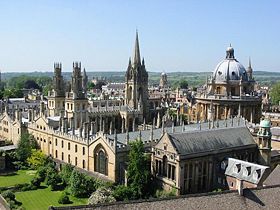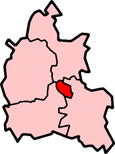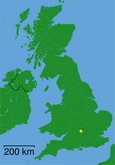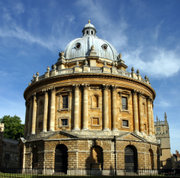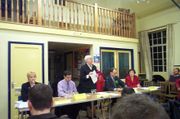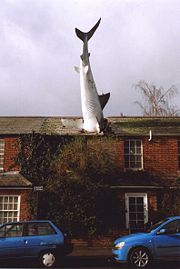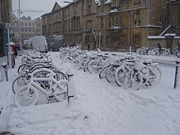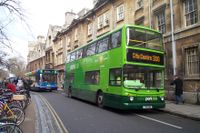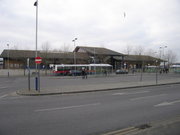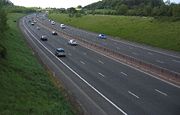Oxford
2008/9 Schools Wikipedia Selection. Related subjects: British Cities; Great Britain
| Oxford | |
| Skyline of the city of Oxford | |
| Nickname(s): "The City of Dreaming Spires" | |
| Motto: "Fortis est veritas" "Truth is strong" | |
| Shown within Oxfordshire | |
| Oxford shown within United Kingdom | |
| Coordinates: | |
|---|---|
| Sovereign state | United Kingdom |
| Constituent country | England |
| Region | South East England |
| Ceremonial county | |
| Admin HQ | Oxford City Centre |
| Founded | 9th century |
| Town charter | |
| City status | 1542 |
| Government | |
| - Type | City |
| - Governing body | Oxford City Council |
| - Lord Mayor | Susanna Pressel |
| - MPs: | Evan Harris (LD) Andrew Smith (L) |
| Area | |
| - Total | 17.6 sq mi (45.59 km²) |
| Population (2006 est.) | |
| - Total | 149,100 ( Ranked 112th) |
| - Density | 8,469.3/sq mi (3,270/km²) |
| - Ethnicity ( 2005 Estimates |
73.0% White British 9.1% Other White 5.7% South Asian 3.0% Black 2.9% Chinese 2.7% Mixed Race 1.9% Other 1.8% White Irish |
| Time zone | Greenwich Mean Time ( UTC+0) |
| Postcode | OX |
| Area code(s) | 01865 |
| ISO 3166-2 | GB-OXF |
| ONS code | 38UC |
| OS grid reference | SP513061 |
| NUTS 3 | |
| Website: www.oxford.gov.uk | |
Oxford (pronounced /'ɒksfəd/, listen ) is a city, and the county town of Oxfordshire, in South East England. It has a population of 134,248 (2001 census). The River Thames runs through Oxford, where for a distance of some 10 miles (16 km) it is known as The Isis.
Oxford is home to the University of Oxford, the oldest university in the English-speaking world.
Buildings in Oxford reflect every English architectural period since the arrival of the Saxons, including the mid-18th century Radcliffe Camera, the hub of the city. Oxford is known as the "city of dreaming spires", a term coined by poet Matthew Arnold in reference to the harmonious architecture of Oxford's university buildings.
History
Oxford was first occupied in Saxon times, and was initially known as "Oxenaforda", meaning " Ford of the Ox"; fords being very important before the days of bridges. It began with the foundation of St Frideswide's nunnery in the 8th century, and was first mentioned in written records in the Anglo-Saxon Chronicle for the year 912. In the 10th century Oxford became an important military frontier town between the kingdoms of Mercia and Wessex and was on several occasions raided by Danes. St Frideswide is the patron saint of both the city and university.
In 1191, a city charter stated in Latin:
“Be it known to all those present and future that we, the citizens of Oxford of the Commune of the City and of the Merchant Guild have given, and by this, our present charter, confirm the donation of the island of Midney with all those things pertaining to it, to the Church of St. Mary at Oseney and to the canons serving God in that place.
“Since, every year, at Michaelmas the said canons render half a mark of silver for their tenure at the time when we have ordered it as witnesses the legal deed of our ancestors which they made concerning the gift of this same island; and besides, because we have undertaken on our own part and on behalf of our heirs to guarantee the aforesaid island to the same canons wheresoever and against all men; they themselves, by this guarantee, will pay to us and our heirs each year at Easter another half mark which we have demanded; and we and our heirs faithfully will guarantee the aforesaid tenement to them for the service of the aforesaid mark annually for all matters and all services.
“We have made this concession and confirmation in the Common council of the City and we have confirmed it with our common seal. These are those who have made this concession and confirmation.”
(There follows a list of witnesses, ending with the phrase, “… and all the Commune of the City of Oxford.”)
The prestige of Oxford is seen in the fact that it received a charter from King Henry II, granting its citizens the same privileges and exemptions as those enjoyed by the capital of the kingdom; and various important religious houses were founded in or near the city. A grandson of King John established Rewley Abbey for the Cistercian Order; and friars of various orders ( Dominicans, Franciscans, Carmelites, Augustinians, and Trinitarians), all had houses at Oxford of varying importance. Parliaments were often held in the city during the thirteenth century. The Provisions of Oxford were installed by a group of barons led by Simon de Montfort; these documents are often regarded as England's first written constitution.
The University of Oxford is first mentioned in 12th century records. Oxford's earliest colleges were University College (1249), Balliol (1263) and Merton (1264). These colleges were established at a time when Europeans were starting to translate the writings of Greek philosophers. These writings challenged European ideology – inspiring scientific discoveries and advancements in the arts – as society began seeing itself in a new way. These colleges at Oxford were supported by the Church in hopes to reconcile Greek Philosophy and Christian Theology. The relationship between " town and gown" has often been uneasy — as many as 93 students and townspeople were killed in the St Scholastica Day Riot of 1355.
Christ Church Cathedral, Oxford is unique as a college chapel and cathedral in one foundation. Originally the Priory Church of St Frideswide, the building was extended and incorporated into the structure of the Cardinal's College shortly before its refounding as Christ Church in 1546, since which time it has functioned as the cathedral of the Diocese of Oxford.
The Oxford Martyrs were tried for heresy in 1555 and subsequently burnt at the stake, on what is now Broad Street, for their religious beliefs and teachings. The three martyrs were the bishops Hugh Latimer and Nicholas Ridley, and the Archbishop Thomas Cranmer.
During the English Civil War, Oxford housed the court of Charles I in 1642, after the king was expelled from London, although there was strong support in the town for the Parliamentarian cause. The town yielded to Parliamentarian forces under General Fairfax in the Siege of Oxford of 1646. It later housed the court of Charles II during the Great Plague of London in 1665-66. Although reluctant to do so, he was forced to evacuate when the plague got too close.
In 1790 the Oxford Canal connected the city with Coventry. The Duke's Cut was completed by the Duke of Marlborough in 1789 to link the new canal with the River Thames; and in 1796 the Oxford Canal company built their own link to the Thames, at Isis Lock. In the 1840s, the Great Western Railway and London and North Western Railway linked Oxford with London.
In the 19th century, the controversy surrounding the Oxford Movement in the Anglican Church drew attention to the city as a focus of theological thought.
Oxford's Town Hall was built by Henry T. Hare, the foundation stone was laid on 6 July 1893 and opened by the future King Edward VII on 12 May 1897. The site has been the seat of local government since the Guild Hall of 1292 and though Oxford is a city and a Lord Mayoralty, it is still called by its traditional name of " Town Hall".
By the early 20th century, Oxford was experiencing rapid industrial and population growth, with the printing and publishing industries becoming well established by the 1920s. Also during that decade, the economy and society of Oxford underwent a huge transformation as William Morris established the Morris Motor Company to mass produce cars in Cowley, on the south-eastern edge of the city. By the early 1970s over 20,000 people worked in Cowley at the huge Morris Motors and Pressed Steel Fisher plants. By this time Oxford was a city of two halves: the university city to the west of Magdalen Bridge (from where students traditionally jump into the River Cherwell every May Day morning) and the car town to the east. This led to the witticism that "Oxford is the left bank of Cowley". Cowley suffered major job losses in the 1980s and 1990s during the decline of British Leyland, but is now producing the successful New MINI for BMW on a smaller site. A large area of the original car manufacturing facility at Cowley was demolished in the 1990s and is now the site of a major business park.
The influx of migrant labour to the car plants and hospitals, recent immigration from south-east Asia, and a large student population, have given Oxford a notable cosmopolitan character, especially in the Headington and Cowley Road areas with their many bars, cafes, restaurants, clubs, ethnic shops and fast food outlets. Oxford is one of the most diverse small cities in Britain with the most recent population estimates for 2005. showing that 27% of the population were from an ethnic minority group, including 16.2% from a non-white ethnic minority ethnic group (ONS). These figures do not take into account more recent international migration into the city, with over 10,000 people from overseas registering for National Insurance Numbers in Oxford between 2005/06 and 2006/07. .
On 6 May 1954, Roger Bannister, as a 25 year old medical student, ran the first authenticated four-minute mile at the Iffley Road running track in Oxford.
Oxford's second university, Oxford Brookes University, formerly the Oxford School of Art, based on Headington Hill, was given its charter in 1991 and has been voted for the last five years the best new university in the UK.
Politics and governance
Many important and famous politicians and people in the political public eye were resident in Oxford, often due to their membership of the University. Most notably of recent times, this list includes Osama bin Laden and Benazir Bhutto.
Oxford City Council
Despite stereotypes of Oxford being a conservative city, there are no elected Conservatives on the city council, although two Liberal Democrat councillors briefly sat as Conservatives during 2007-8. Since the 2004 local elections, the council has been in minority administration, first by councillors from the Labour Party, with the Liberal Democrats being the official opposition. In 2006 these roles were reversed, although two years later, the unpopularity of the Liberal Democrat administration led to the election once again of a minority Labour administration . With seven city councillors and five county councillors, Oxford has one of the highest Green Party representation for a UK city. The Independent Working Class Association has two councillors, although their support is confined to a ward in the Blackbird Leys housing estate in the south east of the city. See Oxford Council election 2004 for further information.
Since 2002, elections have been held for Oxford City Council in even years, with each councillor serving a term of four years. Each electoral ward within Oxford is represented by two councillors, thus all wards elect one councillor at each election. Prior to 2002, the City Council was elected by thirds.
In early 2003, the Oxford City Council submitted a bid to become a unitary authority. This was received by Communities and Local Government but subsequently rejected.
- Partisan Composition
| Year | Labour | Lib Dem | Green | IWCA | Independent | Conservative | Source |
|---|---|---|---|---|---|---|---|
| 2000 | 21 | 21 | 7 | 1 | 0 | 1 | |
| 2002 | 29 | 15 | 3 | 1 | 0 | 0 | |
| 2004 | 20 | 18 | 7 | 3 | 0 | 0 | |
| 2006 | 17 | 19 | 8 | 4 | 0 | 0 | |
| 2008 | 23 | 16 | 7 | 2 | 0 | 0 |
- Partisan control
- 1974 – 1976: Labour
- 1976 – 1980: Conservative
- 1980 – 2000: Labour
- 2000 – 2002: No overall control
- 2002 – 2004: Labour
- 2004 – Present: No overall control
Parliamentary representation
The two MPs are Andrew Smith from the Oxford East constituency, erstwhile Secretary of State for Work and Pensions in the Labour government; and Dr Evan Harris from the Oxford West and Abingdon constituency, Liberal Democrat science spokesman. At the 2005 general election, Oxford East became a marginal seat with a Labour majority over the Liberal Democrats of just 963. Oxford West and Abingdon is a safe seat for the Liberal Democrats with Dr Harris enjoying a majority of just under 8,000.
Parishes
Oxford has four civil parishes with parish councils – these are Blackbird Leys, Littlemore, Old Marston and Risinghurst and Sandhills. Littlemore, Marston and Risinghurst and Sandhills have only recently been brought within the city boundary.
Geography
Oxford's latitude and longitude are (at Carfax Tower, which is usually considered the centre).
Wards, neighbourhoods, and suburbs
- Abingdon
- Barton
- Binsey
- Blackbird Leys
- Botley
- Cowley
- East Oxford
- Cutteslowe
- Donnington
- Grandpont
- Headington
- Iffley
- Littlemore
- Jericho
- Marston
- North Oxford
- Northway
- Osney
- Rose Hill
- Risinghurst
- Sandhills
- St Ebbes
- Summertown
- Temple Cowley
- Wolvercote
- Waterways
- Wood Farm
Climate
Oxford has a Maritime Temperate climate ("Cfb" by Köppen classification). Precipitation is uniformally distributed throughout the year and is provided mostly by weather systems that arrive from the Atlantic. The lowest temperature ever recorded in Oxford was -16.6°C (2°F) in January 1982. The highest temperature ever recorded in Oxford is 35.6°C (96°F) in August 2003 during the 2003 European heat wave.
There is a field of thought that due to Climate change, temperatures are increasing in Oxford, precipitation is decreasing in summer and increasing in winter.
The average conditions below are from the Radcliffe Meteorological Station. It boasts the longest series of temperature and rainfall records for one site in Britain. These records are continuous from January, 1815. Irregular observations of rainfall, cloud and temperature exist from 1767.
| Weather averages for Oxford, UK | |||||||||||||
|---|---|---|---|---|---|---|---|---|---|---|---|---|---|
| Month | Jan | Feb | Mar | Apr | May | Jun | Jul | Aug | Sep | Oct | Nov | Dec | Year |
| Average high °C (°F) | 6.8 (44) | 7.4 (45) | 10.1 (50) | 13.0 (55) | 16.7 (62) | 19.8 (68) | 21.7 (71) | 21.2 (70) | 18.5 (65) | 14.2 (58) | 9.8 (50) | 7.4 (45) | 13.9 (57) |
| Average low °C (°F) | 1.4 (35) | 1.4 (35) | 2.5 (37) | 4.3 (40) | 7.2 (45) | 10.2 (50) | 12.2 (54) | 11.9 (53) | 9.8 (50) | 6.8 (44) | 3.8 (39) | 2.1 (36) | 6.1 (43) |
| Precipitation mm (inches) | 52.6 (2.07) | 41.0 (1.61) | 41.1 (1.62) | 43.9 (1.73) | 50.6 (1.99) | 53.3 (2.1) | 59.5 (2.34) | 58.3 (2.3) | 60.3 (2.37) | 65.3 (2.57) | 61.8 (2.43) | 55.8 (2.2) | 643.5 (25.33) |
| Source: Radcliffe Meteorological Station ( NB: Data from the period 1881-2004) 2008-03-17 | |||||||||||||
Economy
The Oxford suburb of Cowley has a long history of carmaking and now produces the BMW MINI.
Brewing
Morrells, the Oxford based regional brewery was founded in 1743 by Richard Tawney. He formed a partnership in 1782 with Mark and James Morrell, who eventually became the owners. The brewery building, known as the "Lion Brewery", was located in St Thomas Street. It closed in 1998, the beer brand names being taken over by the Thomas Hardy Burtonwood brewery., while the 132 tied pubs were bought by "Morrells of Oxford", who sold the bulk of them on to Greene King in 2002. The Lion Brewery was converted into luxury apartments in 2002.
Commercial areas
- Cornmarket Street
- Queen Street, Oxford
- The High Street
- Turl Street
- Little Clarendon Street
- Broad Street
- The Covered Market
- George Street
- Clarendon Shopping Centre
- Westgate Shopping Centre
- Golden Cross
Outside the City Centre:
- Iffley Road, Oxford
- Cowley Road, Oxford
- Templars Square Shopping Centre, Cowley, Oxford
- St. Clements, Oxford
- London Road, Headington, Oxford
- Banbury Road, Summertown, Oxford
- Walton Street, Jericho, Oxford
- Botley Road, Oxford
- North Parade, Oxford
- Cowley Retail Park, Cowley, Oxford
Theatres and cinemas
- Oxford Playhouse, Beaumont Street
- New Theatre, George Street
- Burton Taylor Theatre, Worcester Street
- Old Fire Station Theatre, George Street
- Pegasus Theatre, Magdalen Road
- Ultimate Picture Palace, Cowley Road
- Phoenix Picturehouse, Walton Street
- Odeon Cinema, George Street
- Odeon Cinema, Magdalen Street
- Vue Cinema, Grenoble Road
Landmarks
Oxford has numerous major tourist attractions, many belonging to the university and colleges. As well as several famous institutions, the town centre is home to Carfax Tower and the University Church of St Mary the Virgin, both of which offer views over the spires of the city. Many tourists shop at the historic Covered Market. In the summer punting on the Thames/Isis and the Cherwell is popular.
Transport
Buses
Oxford has 5 park and ride sites that service the city centre;
- Pear Tree (Link to city centre with bus 300)
- Water Eaton (Link to city centre with bus 500)
- Thornhill (Link to city centre with bus 400)
- Redbridge (Link to city centre with bus 400)
- Seacourt (Link to city centre with bus 300)
A service also runs to The John Radcliffe Hospital (from Thornhill/Water Eaton) as well as the Churchill and Nuffield Hospitals (from Thornhill).
Standard bus services are provided by the Oxford Bus Company and Stagecoach Oxfordshire. Both companies also operate regular services to London.
Rail
Oxford railway station is placed out of the city centre. The station is served by numerous routes, including CrossCountry services as far afield as Manchester and Edinburgh, First Great Western (who operate the station) services to London and other destinations and occasional Chiltern Railways services to Birmingham. The present station opened in 1852.
Roads
A roads
The city has a ring road that consists of the A34, the A40 and the A4142. It is mostly dual carriageway and was completed in 1966. The main roads that lead out of Oxford are:
- A40- which leads to London and High Wycombe (as well as the M40 motorway south) to the east, and Cheltenham, Gloucester and south Wales to the west.
- A34- which leads to Bicester, the M40 north, Birmingham and Manchester to the north, and Didcot, Newbury and Winchester to the south. The A34 is entirely grade separated dual carriageway all the way from Bicester to Winchester.
- A44- which begins in Oxford and leads to Worcester, Hereford and Aberystwyth.
- A420- which also begins in Oxford and leads to Bristol passing Swindon and Chippenham.
Motorways
The city is served by the M40 motorway, which connects London to Birmingham. The original M40 opened in 1974 went from London to Waterstock where the A40 continued to Oxford. However, when the M40 was extended to Birmingham in 1991, a mile of the old motorway became a spur and the new section bended away sharply north. Now the M40 does a large arc around Oxford (staying around 10 miles (16 km) away from the centre) due to the woodland that the motorway had to avoid. The M40 meets the A34 a junction later, the latter now being in two parts, the A34 restarting in Birmingham.
Education
There are two universities in Oxford; the University of Oxford and Oxford Brookes University as well as Ruskin College, a normal university.
Oxford is home to wide range of schools many of which receive pupils from around the world. Three are University choral foundations, established to educate the boy choristers of the chapel choirs, and have kept the tradition of single sex education. Examination results in state-run Oxford schools are consistently below the national average and regional average however results in the city are improving with 44% of pupils gaining 5 grades A*-C in 2006.
Culture
Literature and film
Well-known Oxford-based authors include:
- Oscar Wilde a nineteenth century poet and author who attended Oxford from 1874 to 1878.
- Susan Cooper who is best known for her The Dark Is Rising Sequence
- Lewis Carroll (real name Charles Lutwidge Dodgson), Student and Mathematical Lecturer of Christ Church.
- Colin Dexter who wrote and set his Inspector Morse detective novels in Oxford. Colin Dexter still lives in Oxford.
- John Donaldson (d.1989), a poet resident in Oxford in later life.
- Siobhan Dowd Oxford resident; who was an undergraduate at Lady Margaret Hall, Oxford.
- Kenneth Graham educated at St. Edward's School, Oxford
- Michael Innes (J. I. M. Stewart), of Christ Church.
- P. D. James who lives part-time in Oxford.
- T. E. Lawrence, "Lawrence of Arabia", Oxford resident, undergraduate at Jesus, postgraduate at Magdalen.
- C. S. Lewis, Fellow of Magdalen.
- Ian McEwan, formerly an Oxford resident for many years.
- Iris Murdoch, Fellow of St Anne's.
- Mike Philbin, wrote his infamous Hertzan Chimera novels/stories in Oxford.
- Iain Pears, undergraduate at Wadham College and Oxford resident, whose novel An Instance of the Fingerpost is set in the city.
- Philip Pullman who was an undergraduate at Exeter.
- Dorothy L. Sayers who was an undergraduate at Somerville.
- J. R. R. Tolkien, undergraduate at Exeter and later professor of English at Merton.
Oxford appears in the following works:
- Jude the Obscure (1895) by Thomas Hardy (in which Oxford is thinly disguised as " Christminster").
- Zuleika Dobson (1911) by Max Beerbohm.
- Gaudy Night (1935) by Dorothy L. Sayers.
- Brideshead Revisited (1945) by Evelyn Waugh.
- A Question of Upbringing (1951 ) by Anthony Powell
- Second Generation (1964 novel) by Raymond Williams
- The Children of Men (1992) by P. D. James.
- His Dark Materials (1995 onwards) by Philip Pullman
- Endymion Spring (2006) by Matthew Skelton
Sport
Oxford is considered to be an important centre of the sport of swimming in England. The Amateur Swimming Association was founded in 1869 in England, but it was much later, in 1909, that Oxford Swimming Club came into existence. In 1939 Oxford had its first major public indoor pool at Temple Cowley in the whole of England. After the pool was installed, swimming began to take off and soon Oxford Swimming Club became Oxford City Swimming Club, and Temple Cowley Pool was its home.
Speedway racing has been staged on and off in Oxford since 1939 at Cowley Stadium. Most recently, it held Elite League Speedway and Conference League Speedway until 2007, when landlords Greyhound Racing Association apparently doubled the rent. Speedway, for the time being, is not running in Oxford. Details of the 1949 and 1950 seasons at Cowley can be viewed on Oxford Speedway website.
Oxford is also home to Oxford United, who are currently in the Conference National, the highest tier of non-league football, but have seen great success in the past, mainly in winning the League Cup in the 80's and being one of the highest teams in the football league.
Twinning
Oxford's twin cities are:
All of these are university towns, except for
 Oxford, Michigan, United States
Oxford, Michigan, United States
